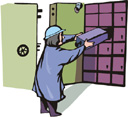What Banks Do
Part 2: Now You See It, Now You Don't
Banks also offer loans. A loan is an amount of money that a bank gives to a person or business so that person or business can buy something that he or she or it doesn't normally have enough money to buy, such as a house or a car or a piece of equipment. A person or business signs a piece of paper that specifies how much money the bank will lend and when the person or business intends to pay the money back. Banks charge interest on loans. This is one of the primary ways that banks make money. It is always more expensive to buy something on loan, since by the time you pay off the loan, including all the interest, you will have paid two or three or more times the amount of the original purchase price. People take out loans so that they can pay for things over a period of time, not all at once. Banks make a lot of money on loans. The banks also make money by charging customers for having checking and savings accounts. A customer might pay a small fee just for having an account. A common fee is for having less than the minimum amount of money in an account. (This is another way that banks ensure money flow.)
The other kind of card that customers routinely use to purchase things is a credit card. This kind of card is an electronic form of borrowing. Each time a person uses a credit card, he or she increases the money owed to the bank that issued the credit card. One of the main payments that each person or business makes each month is to pay off the balance on a credit card. Banks and customers make wide use of the Internet these days as well. More and more transactions are done on secure websites, enabling people to avoid having to get up from their chairs to exchange money. First page > Money In, Money Out > Page 1, 2 |
|
Social Studies for Kids
copyright 2002–2024
David White



 Another service that banks routinely offer is a safe deposit box. A person might have valuable jewelry, or a business might have valuable documents. A bank will offer a special metal box as a storage space for that jewelry or those documents. Safe deposit boxes are kept in a secure area of the bank, usually in a safe, and it takes two keys to open such a box: The person who is renting the box will have one key, and the bank will have the other; without both keys, a person cannot open the box. People use safe deposit boxes to store valuable material because the security surrounding safe deposit boxes is much better than what people would normally have at home or business would normally have at work.
Another service that banks routinely offer is a safe deposit box. A person might have valuable jewelry, or a business might have valuable documents. A bank will offer a special metal box as a storage space for that jewelry or those documents. Safe deposit boxes are kept in a secure area of the bank, usually in a safe, and it takes two keys to open such a box: The person who is renting the box will have one key, and the bank will have the other; without both keys, a person cannot open the box. People use safe deposit boxes to store valuable material because the security surrounding safe deposit boxes is much better than what people would normally have at home or business would normally have at work. With the widespread use of computers these days, nearly all of a bank's record-keeping and money transfers are done electronically. People still write checks, a lot in some cases, but electronic money transfers are far more common. One common way that people pay for things is with an ATM or EFTPOS card. These cards are debit cards that are connected directly to a bank account. Businesses use special machines that accept such cards, requiring customers to key in PIN numbers, with the result being that the money to pay for the purchase is taken out of the corresponding bank account immediately.
With the widespread use of computers these days, nearly all of a bank's record-keeping and money transfers are done electronically. People still write checks, a lot in some cases, but electronic money transfers are far more common. One common way that people pay for things is with an ATM or EFTPOS card. These cards are debit cards that are connected directly to a bank account. Businesses use special machines that accept such cards, requiring customers to key in PIN numbers, with the result being that the money to pay for the purchase is taken out of the corresponding bank account immediately.
